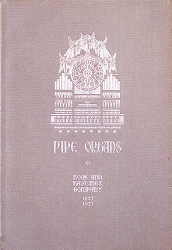 
E. & G. G. Hook - Hook and Hastings
|
|
One way in which to approach the evolution of the nineteenth-century American organ is to look at representative works of a single firm. We could look at any one of several builders in the early part of the century, but they didn't all continue through the late 1800's. Some of the well-known twentieth-century firms -- M. P. Möller and Schantz, for example -- had their beginnings in the late nineteenth century, but they started too late. We would have no examples from the first half of the century to study. The Hook firm, however, started business well before the outbreak of the Civil War, and they were still building and selling organs after World War I. Their instruments were placed in virtually every state in the nation, and some of them are still in use. In short, they provide a good example for our study. In many ways, the story of the the Hooks fits the stereotype of entrepreneurial success stories in the nineteenth century. Brothers Elias and George began their careers as apprentices to William Goodrich in 1824, opened their own shop in 1827, and moved their shop to Boston in 1831. There they built organs under the banner of their jointly named business: E. and G. G. Hook. With the passage of time, the business grew and the number of employees increased to match. One of the people added to the employee list in the 1850's, Francis Hastings, was eventually made a partner to the brothers. Instruments built after 1872, then, were produced by the enlarged firm, known as E. & G. G. Hookand Hastings, or -- later -- simply Hook and Hastings. The firm was continually in business for over 100 years, and it still bore the name of its founders even after their deaths in the 1880's and the death of Hastings in 1916. Early instruments were built for local use, and as time went on their scope expanded with the nation. They built organs for use in churches, in schools, and in public halls. The instruments ranged in size from small one-manual organs to large four-manual organs that received widespread favorable notice. In short -- we can find in their work virtually all of the characteristics and developments of the nineteenth-century organ in the United States.219 If this were a perfect world, we could call up the company and ask for their help in surveying their instruments of the period. Unfortunately, we can't do that, because the Great Depression caused the firm to close in 1936. To make matters even worse, the official records and documents of the firm are lost. So -- where do we get the information we need?
By studying some surviving instruments and a variety of published sources, then, we can get a good idea of the overall nature both of their instruments and of their development as builders through the end of the nineteenth century. © 2001 AD James H. Cook |